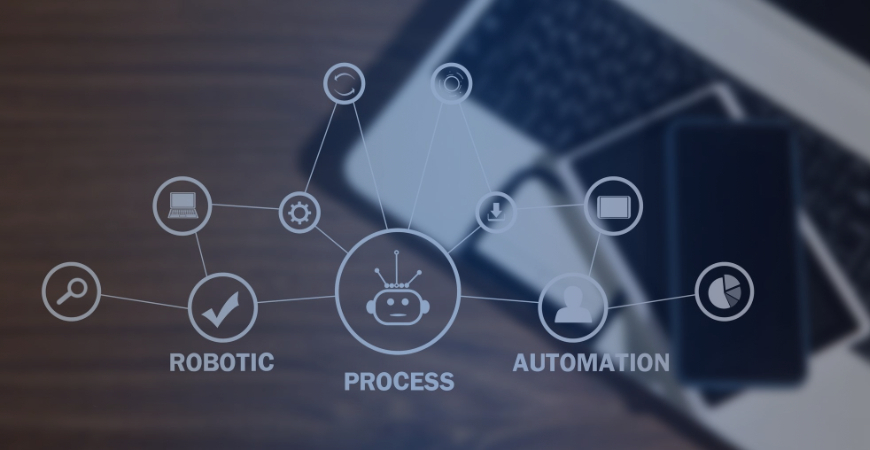Section
4 Use cases of automation and digitization
In this digital age, automation and digitization are essential for businesses of all sizes. In this blog, we look at four ways your company can benefit from automation and digitization, from reducing costs to improving customer experiences.
The term ‘Digital Transformation’ and its real-world significance have expanded in this new decade of the 21st century, as a force driving the next phase of modernization in information technologies and systems. From keeping up with increasing digital adoption among consumers to ensuring business continuity in the face of global events like the COVID-19 pandemic, the need for adopting the latest enterprise technologies has become mandatory rather than a choice.
According to IDC, global spending on digital transformation technologies and services is projected to reach $2.3 trillion by 2023. At the same time, the enterprise software segment is expected to clock $243.30 billion in revenues in 2022, marking an increased demand for digital and Software-as-a-Service (SaaS) platforms to fast-track digitalization.
Artificial Intelligence (AI) and Machine learning (ML) have advanced rapidly over the last few years, creating new opportunities to use them for business efficiency through automation and analytics. This new wave of digital transformation is all about analyzing the current level of maturity and enhancing systems further to leverage automation for various use cases. For this, understanding the changing roles of AI in digital transformation is the best way to gauge your automation needs and find the right way forward.
AI is a key driver of digitization and automation
At the core, digitization and digitalization are all about how information is shared, interpreted, and applied by businesses in their processes and decision-making. And artificial intelligence is one of the biggest driving forces of digital transformation. AI does much more than performing simple, repeatable tasks, and can also aid in building a self-governing and updating digital infrastructure with machine learning, handling day-to-day data classification and management, and helping in creating a robust automation system that connects processes and makes them autonomous.
From creating a smart data analytics platform to designing an automated business process architecture, AI has evolved by leaps and bounds in terms of what it can achieve. The application of AI in workplace automation shows tremendous promise with the ability to carry out not only in-office processes but also industrial operations.
Let’s look at some key business areas where AI offers deep automation capabilities to help enterprises build scalable, intelligent workflows.
AI and process digitalization: 4 popular use cases
1. Retail and Supply Chain Management
Automation in retail and supply chain management is a real game-changer for organizations. It’s one of the areas where robotic process automation (RPA) and business process automation (BPA) can be used most effectively because of the repetitive, and scalable nature of work. Not only does it help with reducing overhead costs but also improves the quality of supply chain operation while reducing errors. From managing inventory to tracking the shipment until it reaches the final consumer, automation can be incorporated at each step to streamline workflows and make them trackable for all teams involved.
Today, organizations are using supply chain automation to find innovative solutions to issues related to managing order processing, inventory, shipping and logistics, and post-sale customer service. With regards to process automation in daily operations, AI can carry out a variety of manual data input, transfer, recording, and presentation tasks with utmost efficiency, freeing up human resources who only need to ratify these processes and take decisions.
Activities like order fulfillment, product shipment, and maintaining taxation and delivery records can be automated to save logistics costs and time-consuming tasks. For instance, with third-party logistics, automated shipping technology helps businesses find the most efficient route for product shipping.
2. Business Analytics
The modern data-driven business environment demands fast and deep business insights that are not possible for humans to interpret. Using advanced AI and ML systems to support data analytics adds significant value to overall processes, and enables more effective strategies and execution of the same.
The key role of automated data analytics is to simplify and speed insight generation and presentation for the end user, be it an operations executive or a senior leader/decision-maker. Using the natural language generation program, the augmented data analytics system provides easy-to-understand insights that can be accessed by anyone within the organization.
Maintaining transparency in AI is still a major concern in data analytics automation. Tech experts recommend following strict security compliance with data analytics automation to maintain the integrity and security of the data. Here, cloud and DevOps offer an effective way to build agile systems that can be developed, improved, and deployed for better outcomes.
3. Customer Service
The global pandemic forced businesses to reinvent their approach to customer service due to restrictions on physical proximity, and communicate with customers by any means necessary. For traditional B2C brands, the transition from brick and mortar to selling online meant they also needed to engage with them digitally to resolve issues and offer pre- and post-sale support.
AI technologies like chatbots, enabled by machine learning and natural language processing (NLP) played a huge role in making customer interactions more engaging, efficient, and effective. Furthermore, brands that integrate AI with their lead tracking or customer relationship management (CRM) platforms can better analyze lead and customer data to determine how their sales teams or customer success teams should communicate with a lead or customer. They can also use data and analytics more effectively to anticipate customer demands, suggest products or relevant information on products they have purchased, and drive unique, targeted campaigns using email and social media.
4. Human Resource Management
Automation in HR became a necessity as organizations transitioned to remote/hybrid working. With organizations competing to find the best talent in a post-pandemic market with high attrition, automation and digital continue to play a key role in streamlining the recruitment process, making it data-driven, and taking the guesswork out of it for more effective hiring outcomes.
Activities like collecting and processing candidate information and resumes, building a talent database, screening job applications, employee onboarding, employee performance management, and other aspects. With incremental advancements in technology, automation in recruitment is getting more sophisticated to handle complex tasks so that the HR team can focus on core business policies.
Conclusion
AI and digital technologies are always evolving. What started with undertaking shop-floor level tasks can now conduct more complex, high-level tasks with advanced computation and analytical capabilities, specifically for different sectors and business sizes.
Digital adoption and automation will continue to be an integral part of technology strategy for growing enterprises seeking maximum efficiency with minimum costs of running processes and scaling their IT.
Are you planning to incorporate or scale up automation in your business processes? VBeyond Digital offers 360-degree automation solutions from strategy to implementation and support with expertise in the latest cloud systems and methods.




